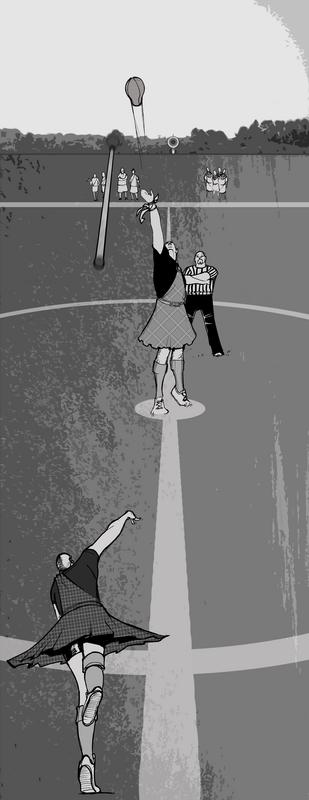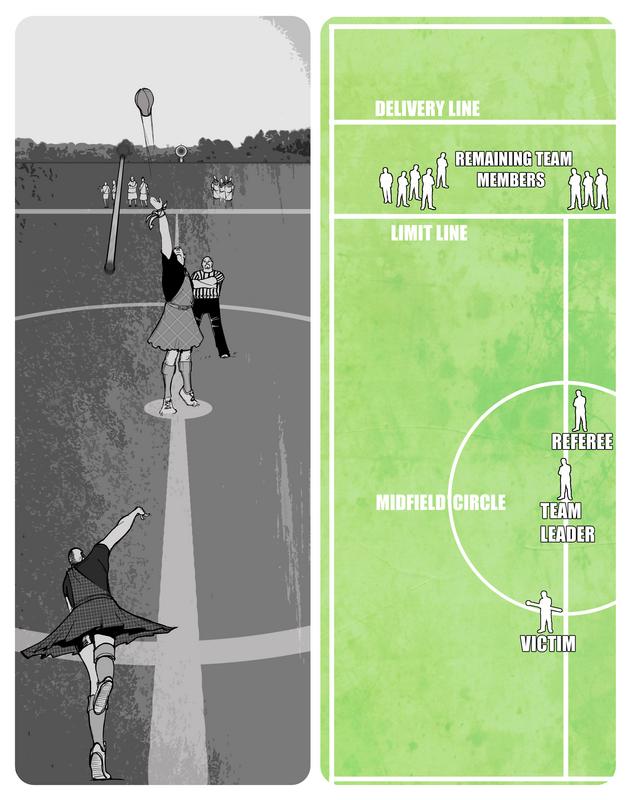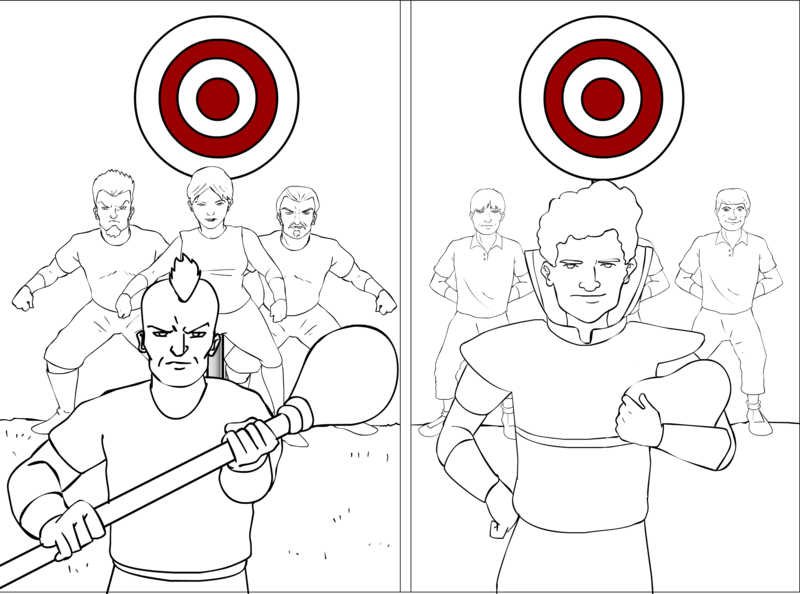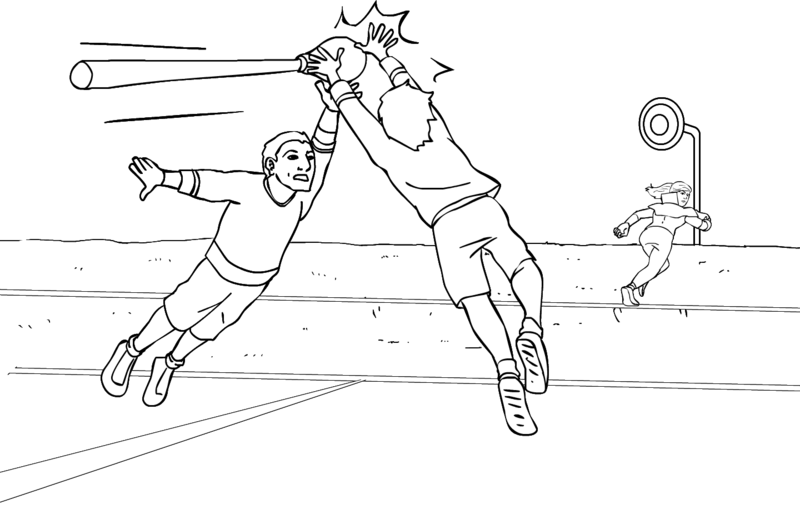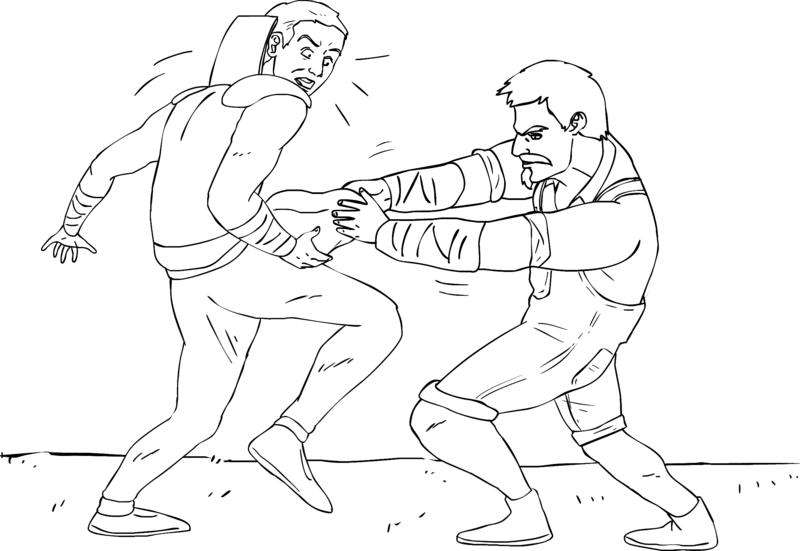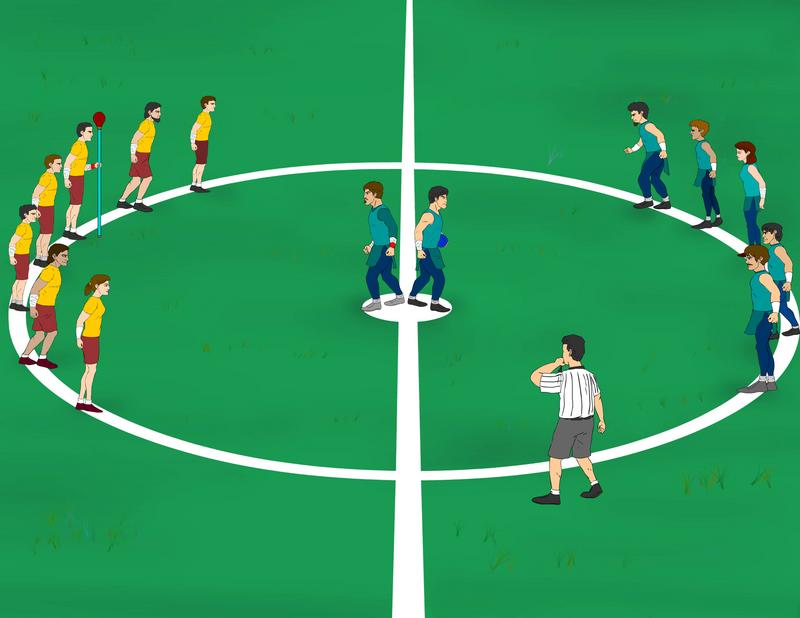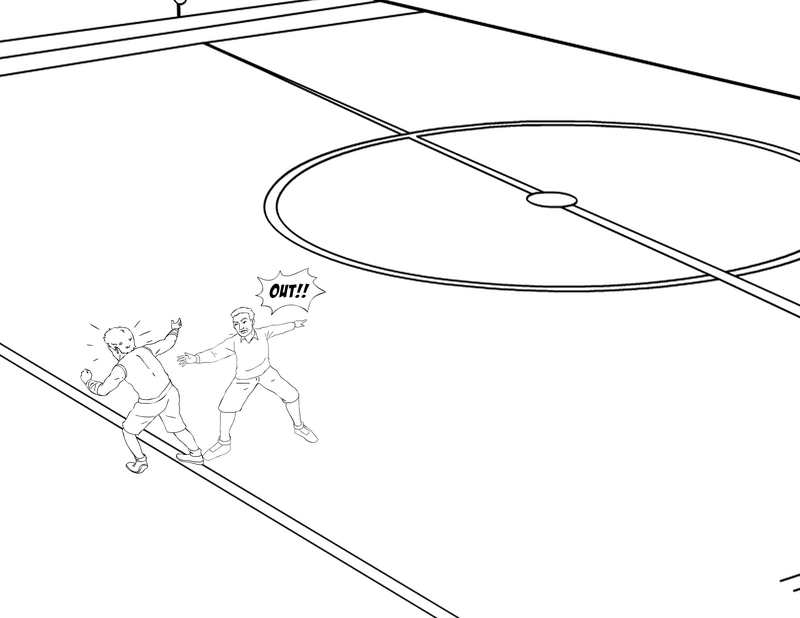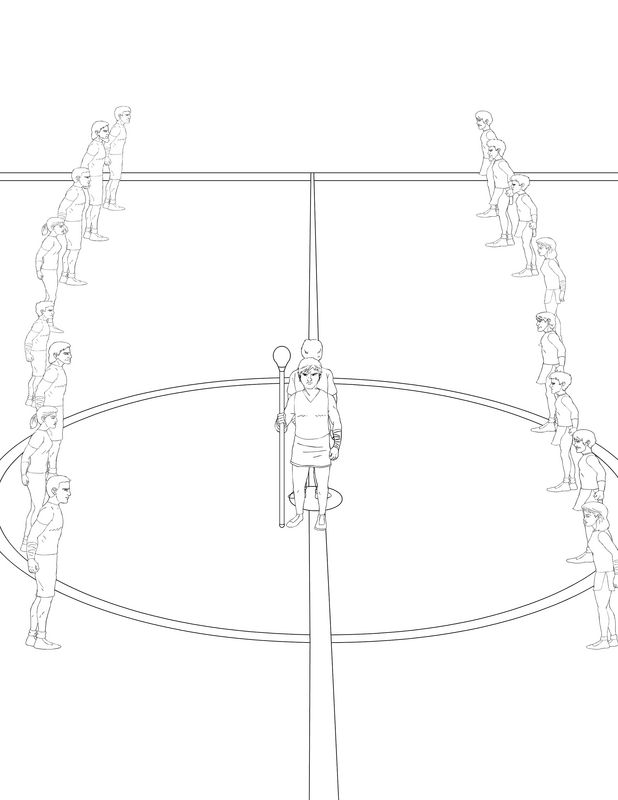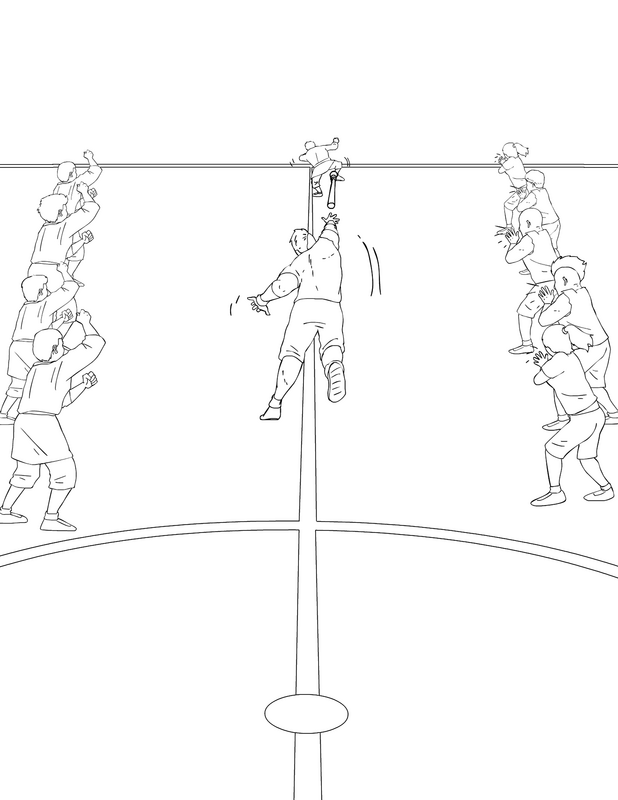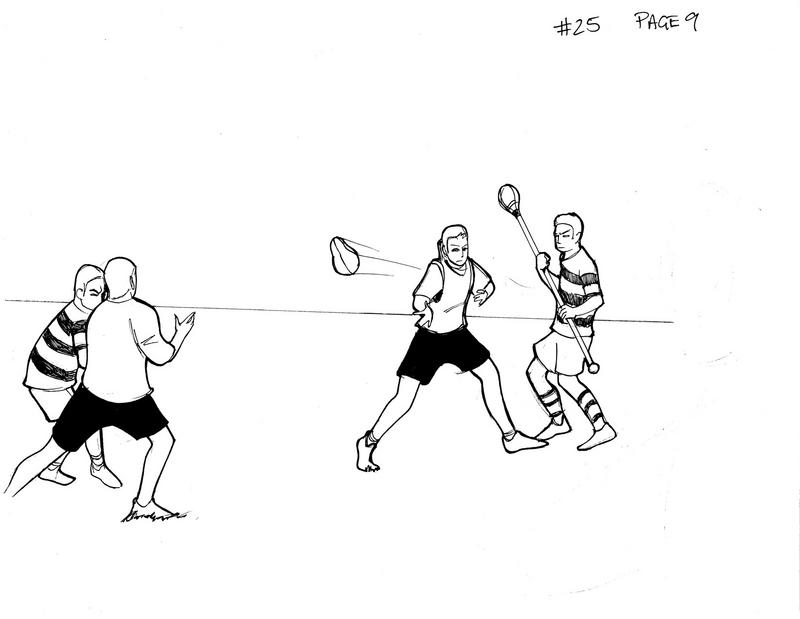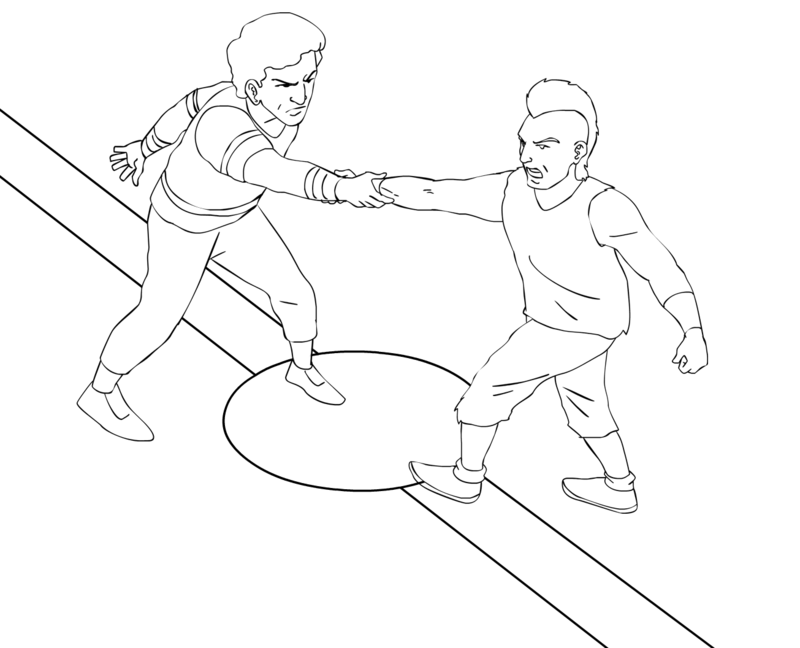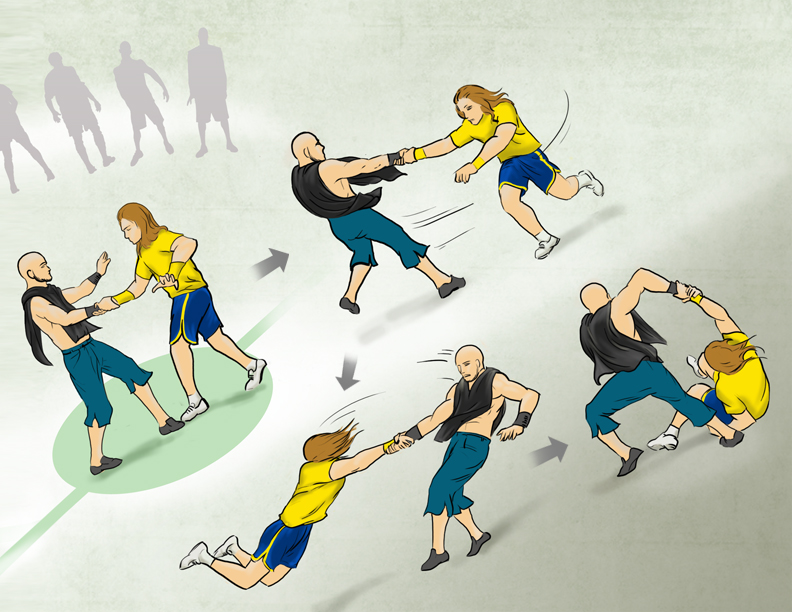Retired to the Midfield Circle:
If a player commits a technical foul and the referee indicates an infraction by shouting the word “out” and gestures by pointing to the player and to the Midfield Circle then that player must immediately run to the Midfield Circle and play out the rest of the round inside the circle. He/she may not step out of the circle until sides switch. He/she may however play normally from inside the circle and should one be called he/she may also participate in Run-downs, Toss-ups and Arm duels. A player who commits a foul after being retired will be removed from the field and must wait for the sides to switch. Upon a second infraction after being retired to the Midfield Circle the referee will use the same signal and shout, “out” but this time he will point to the sidelines where the player must go. The player may not participate in any further play until the sides switch.
The Rule Book Page Eight (8)
You Are On Page Eight (8)
To Page Eleven (11)
To Page Twelve (12)
To Page Thirteen (13)
To Page Fourteen (14)
To Page Fifteen (15)
To Page Sixteen (16)
To Page Seventeen (17)
The Runner is a Target:
The Runner remains a target even if the Runner passes the ball to his teammates. If the Runner is struck by the polearm even though he/she does not have possession of the polearmball then the round ends and the sides switch just the same. The Runner is always a target whether he/she has possession of the polearmball or not. The offense will score a Kill just the same for a speared or jousted Runner even when the Runner does not have the polearmball. In the event that Doubling is attempted the Runner's teammates may not be speared. The polearm may only be thrown at the Runner. The Runner's teammates may be jousted but not speared. Should a Runner's teammate who is in possession of the ball become jousted then a Kill is granted with all the fanfare. The jousted teammate is not worth as much as a jousted Kill against the Runner. In effect upon an attempt to Double the Delivery Score and as soon as the Runner passes the ball to a teammate two human targets emerge. Both the Runner and the teammate in possession of the ball are targets. During a Doubling attempt, there are two human targets instead of one. The dynamics on the playing field change dramatically during a Doubling attempt.
Ball Guidelines:
Offensive players (team in possession of the polearm) may not grab or hold the polearmball while the ball is in an opponent’s possession. A technical foul will occur by an offensive player who grabs, or holds the polearmball in which a defensive player has possession. However, offensive players may slap at the ball which is in possession of the defense.
Polearm Guidelines:
The offensive may pass the polearm at will among their teammates in an unrestricted manner. The polearm may be handed to or thrown to each other. The polearm may be dropped inbounds or touch the ground inbounds without penalty to the offense. If when a polearm is lying on the ground inbounds after a missed throw a defensive player may not touch the polearm. However, the defense may deflect, or block an airborne polearm with their hands, or arms. The defense may attempt to knock an airborne polearm out of bounds which would forfeit the round and a Delivery is automatically awarded to the defensive team. In the role playing aspect of the game this is tantamount to losing all your weapons and being disarmed. You can no longer win.
Except for the runner who may not touch the polearm, the defensive team may touch the polearm with their hands or arms. The runner may not touch the polearm in any way. At no time may a defensive player touch the polearm with his torso. If the polearm touches the torso of a defensive player then that defensive player must retire to the Midfield Circle. A touch by the polearm to the torso of a defensive player constitutes a joust if the polearmist is holding on to the polearm. The offense scores two (2) points for a jousted opponent who is not the Runner and does not have possession of the ball. The defense may block and/or deflect the polearm with their hands and arms or shoulders during a jousting attempt. The defense may deflect or block an airborne polearm with their hands or arms but not the shoulders. However, if the polearm touches a defensive player’s torso during an attempt to block or deflect the polearm whether the polearm is airborne or in possession of an offensive player then that defensive player must retire to the Midfield Circle. (Note: it is not legal for an offensive player to attempt to spear a player who is not the Runner. The offensive player will be cited for committing a personal foul if an opponent who is not the Runner is hit by an intentional airborne polearm.) A defensive player may be jousted from behind; however, the head and neck are off limits. If the defensive player is jousted on the back side of the shoulders then this is considered a successful joust. If the defensive player is jousted on the sides of the shoulders (on the deltoids) then this is not a successful joust.
Should an illegal grab or hold of the polearm occur then the offending player must drop the polearm on the ground where he stands upon the shout of a foul from the referee and retire to the Midfield Circle. Any offensive player may then retrieve the polearm.
Should the polearm go solo with no one in possession and the polearm lands on the ground then the offense alone and only the offense may touch the polearm. Should a defensive player touch the polearm which is solo on the ground whether by his foot or any other part of his body then he will be called out and must retire to the Midfield Circle.
The offense may joust an opponent but cannot throw the polearm at any player other than the Runner. The offense may only joust an opponent on the torso. A joust to the head will be a personal foul and result in a run-down or toss-up or arm duel. The offense may not joust the legs of an opponent. A joust to the legs will be a personal foul and result in a run-down or toss-up or arm duel. The defensive player may deflect the polearm with his hands, arms, front and sides of the shoulders without penalty. Should a defensive player who is not the Runner be struck from behind in the back of the shoulders then this shall be considered a successful joust and the jousted player must be signaled to retire to the Midfield Circle.
How to Double the Value of a Delivery
The defensive players (team that possess the ball) may pass the polearmball among themselves in order to double the value of a Delivery. The first pass from the Runner to one of the Runner’s teammates does not count in the tally. The ball must be passed ten (10) times among the Runner's teammates without passing the ball back to the Runner until the count has been met. The polearmball cannot be passed back to a player which has just passed the polearmball. If this happens then the count starts over until the polearmball has been passed ten (10) times without going back to a player that has just passed the polearmball. The referee will signal that the count must restart by yelling out the word, “restart” and rolling his wrists over each other as a hand signal. A defensive player may not handle the ball more than once until the ball has been passed to a second player after he relinquishes the polearmball. If the polearmball is passed successfully ten (10) times then the ball will need to be returned to the Runner. Once the quota of ten (10) passes is met then the ball should be passed to the Runner as soon as possible. Only the Runner may score a Delivery and must have possession of the polearmball at the time of a Delivery in order to score twelve (12) or twenty four (24) points. Upon satisfying the ten (10) pass quota the referee shall shout the word “double” and point two (2) fingers on one hand up in the air (bunny ears) for all to see. Play continues uninterrupted.
Rules of Engagement:
Offense and Defense
The players on the side trying to make a delivery will be considered to be the defensive players. The players on the side in possession of the polearm who are vying to make a Kill will be considered to be the offensive players.
Offense With Possession of the Polearm
Defense With Possession of the Ball
In this scene the Runner crosses the Delivery Line and looks back as she scores a Delivery to see that her teammates have managed to block the airborne Javel which the opposing team's Polearmist had already pitched toward the target. Bravo!
The Offense may also deflect, grab, hold, intercept or catch the polearmball if it is airborne. If the defense loses the ball due to a successful maneuver upon an airborne ball or the ball is slapped out of a defensive player's possession, then the sides switch and the offense is awarded one (1) point. It is not a Kill. In the role playing aspect of the game, losing the ball is equal to losing your stash and therefore unable to provide food and goods to your village. It could mean a drought, spoilage, accidents, other acts of God such as a storm or flood, fire, etc. If the loss of the ball was due to a foul or illegal maneuver then the game does not lose sides and must be restarted after a foul is called by the referee and played out.
The airborne polearmball may be kicked or hit with the knees or hit with the head.
If a defensive player who is not the Runner is jousted while he/she has possession of the polearmball as when Doubling, then the round ends and the sides switch. Three (3) points are awarded to the offense for the joust.
A defensive player may not allow the ball to touch the ground. If the defense allows the ball to touch the ground due to fumbling, a missed throw, a fall, an interception or deflection, then the sides switch. Loss of the ball is not awarded a Kill.
The ball may not be pulled out of an opponent's hands or held in any way. This is a technical foul which results in the offender being retired to the Midfield Circle where the offender must stay until the round ends. An opponent may slap at the ball and knock it with the hands or arms. If the ball falls to the ground then sides switch. If the ball falls to the ground due to holding then this is a personal foul which results in a penalty round.
Upon completion of a Run-down session or Toss-up session or Arm-duel session, the players shall line up on the perimeter of the Midfield Circle. The teams shall move to the half end (hemisphere) of the side in which the Defense chooses first and spread out evenly to face the opposing team across from the perimeter of the Midfield Circle. The teams must remain on their side of the Hemisphere. The player who had the ball when the foul was called shall stand on the Bull’s Eye in the center of the Midfield Circle holding the polearmball. The Team Leader of the offensive team shall take possession of the polearm and stand among his teammates on their half of the Midfield Circle perimeter.
Rehash...
Run-Downs:
At the discretion of the referee a personal foul may be called against a player who commits unsportsmanlike behavior against another player. A personal foul may also be called if a rule is broken which affects another player in a personal manner. The referee will signal a personal foul with three consecutive whistle blows. Upon sounding three whistle blows all play on the field must cease. All plays in progress on the field must stop. Personal fouls result in either Run-downs, Toss-ups or Arm-duels. The victim will be given the choice to choose which way he/she wants to redeem a personal foul against him/her. The referee will yell out the words “Run down” or “Toss-up” or "Arm-duel" depending on what the victim selected.
If a Run-down was selected then all players must collect themselves and the two teams must line up in two straight lines facing each other with the Bull's Eye and Travel Line centered between them.
The victim and the perpetrator will then be directed to stand on the Bull’s Eye. The victim will hold the polearm vertically with the butt of the polearm resting on the ground and the globe straight up overhead. The perpetrator will wear a runner’s vest and stand on the Bull’s Eye facing back to back with the victim. The two players will be standing facing away from each other as if they were in a duel using pistols. Upon a loud whistle blow by the referee the perpetrator will sprint to the Limit Line 60 feet away straight in front of him following the path of the Travel Line.
The player who was the victim of the foul will at the same time turn around and has the option to run after the perpetrator and either joust him or throw the polearm in an attempt to spear the perpetrator with the polearm from behind. If the victim of the infraction is successful and hits the perpetrator before the perpetrator reaches the Limit Line then the victim scores two (2) points for spearing the perpetrator or three (3) points for jousting the perpetrator. The perpetrator may be hit anywhere on his body by the victim with no penalty. The other team members may shout and gesture so long as they do not interfere with the run-down.
If the perpetrator makes it to the Limit Line without being hit and crosses it then no points are awarded to the victim.
Toss-Ups:
When the victim of a personal foul opts for toss-ups instead of run-downs then the players on both teams are asked to line up at one of the Limit Lines. The victim then stands at the outer edge of the Midfield Circle holding the polearm and faces all the players from both teams. The Team Leader of the victim stands on the Bull’s Eye or Center Mark holding the polearmball. Upon a short whistle blow by the referee the Team Leader throws the polearmball straight up overhead as if to catch the polearmball when it comes down. The victim then throws the polearm and attempts to spear the polearmball in mid air. The victim gets three tries and each time he is successful he scores two (2) points. The other team members may catch the polearm if it reaches them on a miss. The referee will retrieve the polearm from the players or the ground in most cases. In the event that a Team Leader is the victim then the Team Leader may chooseanyone from his/her team to toss the ball up.
Arm-duels:
Upon selection of an Arm-duel the referee shall call out "Arm-duel" and the two teams shall line up on the Midfield Circle line in a circle. The two players playing out the Arm-duel shall stand on the Bull's Eye facing each other with the rest of the players surrounding them on the Midfield Circle. The two players shall grab hold of each others arms as if they were forming a human chain or blockade. Hand-to-Wrist, Hand-to-Wrist. Upon a loud long whistle blow the victim will attempt to Fling the perpetrator to the ground for ten (10) timed seconds in line with the rules for Flinging. When ten seconds have elapsed then the referee shall again blow a long whistle blow. The award for a successful Fling shall be (1) one point. The game is then restarted.
Restart after Run-Downs,Toss-Ups, or Arm-duels:
Upon completion of a run-down session or toss-up session or Arm-duel session, the players shall line up on the perimeter of the Midfield Circle. The teams shall move to the half end (hemisphere) of the side in which the Defense chooses first and spread out evenly to face the opposing team across from the perimeter of the Midfield Circle. The teams must remain on their side of the Hemisphere. The player who had the ball when the foul was called shall stand on the Bull’s Eye in the center of the Midfield Circle holding the polearmball. The Team Leader of the offensive team shall take possession of the polearm and stand among his teammates on their half of the Midfield Circle perimeter. At the discretion of the referee when he sees that the players are in position then the referee shall shout the word, “ready” and give a quick and short blow of the whistle. The teams may now resume play. If the defense was in the process of doubling the value of the Delivery then the count is reset to zero. All human chains which were formed are broken after a foul and the players do not restart as chains.
Once the ball has been returned to the Runner after Doubling then the Runner may not pass the ball. The defensive team may elect to forgo or cut short their attempt to double the value of their Delivery score and consequently pass the ball back to the Runner prematurely. Once the ball is given back to the Runner then the Runner may no longer pass the ball and must attempt his/her Delivery without doubling the value of the Delivery. If passing the ball ten (10) times is attempted but aborted then no harm is done and a Delivery shall be worth twelve (12) points instead of twenty four (24) points. In the role playing aspect of the game, passing the ball to the other teammates is tantamount to filling the sack with more goods. Thus the other members of the team share in the effort to supply goods to their village and help to increase the value of the sack or polearmball.
